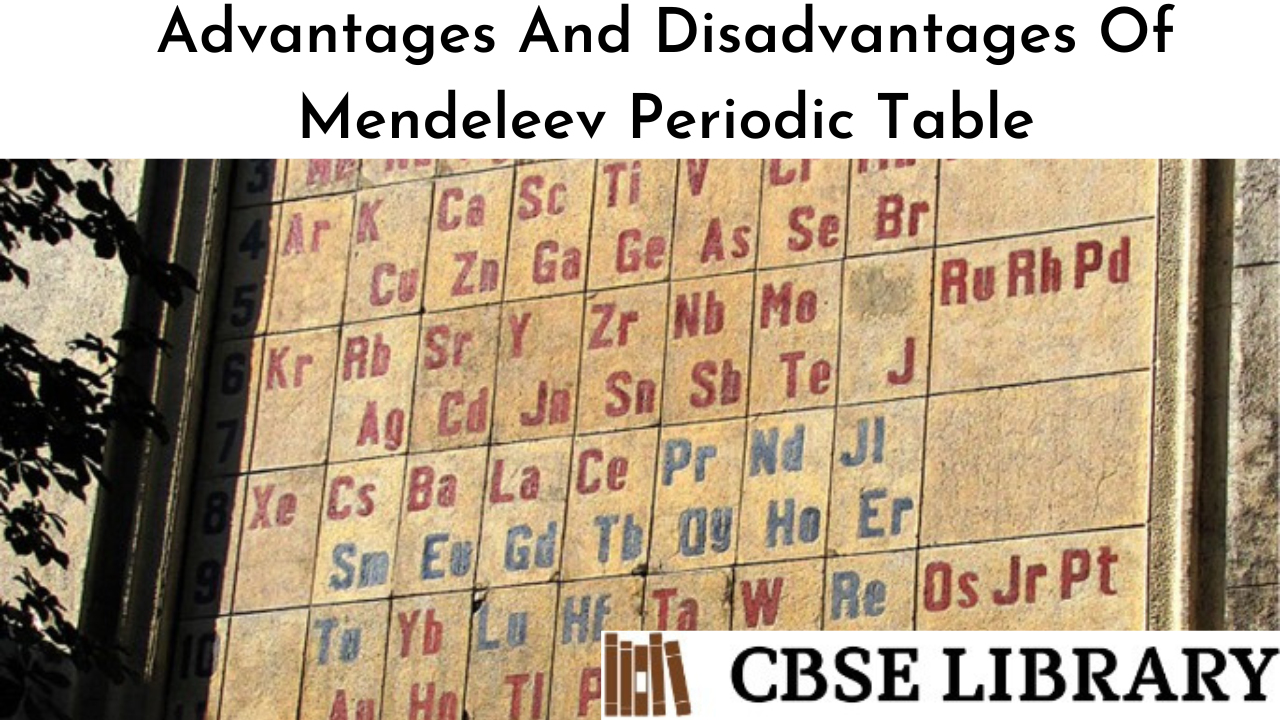Advantages And Disadvantages Of Mendeleev Periodic Table: In 1869, the Mendeleev Periodic Table was introduced after Newlands’ Octave Law was rejected. Mendeleev’s periodic table arranged elements based on their chemical properties, atomic mass, and fundamental properties.
There are currently 118118 elements that we are aware of. The Modern Periodic Table divides these elements into 1818 groups and 77 eras. Dmitri Ivanovich Mendeleev, the Great Scientist, provided a clear core notion for the Modern Periodic Table. In this essay, you will learn the basics of Mendeleev’s Periodic Table law, including its qualities, benefits, and drawbacks.
Students can also find more Advantages and Disadvantages articles on events, persons, sports, technology, and many more.
What is the Mendeleev Periodic Table? Advantages and Disadvantages of Mendeleev Periodic Table 2022
In regards to elements’ physical and chemical properties, Mendeleev’s Periodic Law suggests that their atomic masses determine their properties.
Mendeleev created the periodic table, which was the arrangement of the elements known at the time in increasing order of atomic mass. Vertical columns, referred to as groups, contained elements with similar qualities. Horizontal rows, referred to as periods, contained elements with distinctive properties.
Mendeleev also dubbed undiscovered elements like aluminum, silicon, and Boron Eka-Aluminium, Eka-Silicon, and Eka-Boron. Not only did Mendeleev foresee the existence of Eka-Aluminium, Eka-Silicon, and Eka-Boron, but he also detailed their general physical properties.
Later on, these elements were found and given the names Gallium, Germanium, and Scandium. The periodic table of Mendeleev might anticipate the properties of numerous elements based on their position in the chart. When noble gases were found, Mendeleev’s periodic table could accommodate them.
- Advantages of Mendeleev Periodic table
- Disadvantages of Mendeleev Periodic table
- Comparison Table for Advantages And Disadvantages Of Mendeleev Periodic Table
- FAQ’s on Advantages And Disadvantages Of Mendeleev Periodic Table
Characteristics of Mendeleev’s Periodic Table
- Vertical columns in the periodic table and horizontal rows in the periodic table were designated groups and periods, respectively, in Mendeleev’s periodic table.
- Seven horizontal rows, or periods, are taken into account in the periodic table, with 1 to 7 as the numbers.
- The attributes of elements in the horizontal rows (periods) have a predictable gradient from left to right.
- The periodic table is composed of eight vertical groups or columns, numbered one to eight.
- In order to distinguish elements that are similar but not identical, it is positioned slightly below and to the side of the other. As a result, each column will have two sub-columns A and B, which will facilitate comparisons of components that are in the same sub-column.
- Transition elements belong to group VIII, while normal elements belong to groups I through VII.
- Each of the first group through seventh groups is broken into two subgroups, with Group VIII having three elements.
- The fourth group through the seventh group are divided into two series: the first series and the second series.
- Elements that exhibit similar properties have been grouped together. The first group includes lithium, potassium, rubidium, and other elements.
- The elements of each group in the periodic table have been given two general formulae: one for oxides and the other for hydrides. For example, R2O stands for oxides and RH stands for hydrides in the first group of elements.
- The formulas for oxides and hydrides can be written for the elements in each group using the above general formulae. Hydrogen, sodium, potassium, and other elements in the first group, for example. The general oxide formula for elements in the first group is R2O.
- As a result, they formed H2O, Na2O, K2O, and so on.
Advantages of Mendeleev Periodic table
Mendeleev periodic table has the following advantages:
- Systematic study of elements: Mendeleev was the first to construct a systematic organisation and to demonstrate the periodicity of attributes of elements with atomic weight, as well as to suggest a periodic law.
- Prediction of new elements and their properties: Mendeleev named them by prefixing the name of the preceding element in the same group with the Sanskrit numeral Eka (one). Scandium, gallium, and germanium, for example, were discovered later and have qualities comparable to Eka boron, Eka-aluminium, and Eka silicon.
- No changes in the current arrangements: When noble gases were discovered, they could be grouped together in a new way without upsetting the current arrangement.
- Mendeleev left some gaps in the table for undiscovered elements: Mendeleev left several gaps in his Periodic Table, but he boldly predicted that some modern elements would be present. Rather than considering these gaps to be flawed, he viewed them as opportunities for advancement.
Disadvantages of Mendeleev Periodic table
Mendeleev periodic table has the following disadvantages:
No place for isotopes: Long after Mendeleev proposed his periodic categorization of elements, isotopes were discovered. Isotope positions could not be explained.
Some elements were not in order:
Some of the elements in Mendeleev’s Table haven’t been ordered in the order of increasing atomic masses. Co and Ni, for example, are ranked before Ni in his table despite the fact that Co has a higher atomic mass than Ni.
| Cobalt | Nickel |
| 58.9 amu | 58.7 amu |
The position of hydrogen was not well defined: Hydrogen could not be assigned a definite location in the periodic table (it is found in both the first and seventh groups). Its characteristics are similar to those of alkali metals as well as halogens. Because, like Alkali, it can lose one electron (e-) and acquire one (like Halogens).

Comparison Table for Advantages And Disadvantages Of Mendeleev Periodic Table
| Advantages | Disadvantages |
| The atomic masses and properties of the elements were used to classify them. | The position of hydrogen was not well defined in the periodic table |
| Spaces were left empty to accommodate elements that will be discovered later. | Moving from one element to another caused an irregular increase in atomic mass. |
| It was able to anticipate element properties, which aided in the discovery of new elements. | Mendeleev’s periodic law was broken when isotopes were discovered. |
| The later found inert gas compounds might be put in a different group without disrupting the table. Scandium (sc), Gallium (Ga), and Germanium (Ge) are elements that were discovered after Mendeleev’s periodic table was published. | The number of elements that have yet to be identified was unexpected. |
FAQ’s on Advantages And Disadvantages Of Mendeleev Periodic Table
Question 1.
What’s the difference between Mendeleev’s and modern periodic tables?
Answer:
Mendeleev’s periodic chart is based on atomic mass, which is one of the fundamental differences. The current periodic table is arranged by the number of atoms that each element contains. Because noble gases were not found at the time, they were not included in Mendeleev’s periodic chart. In the modern periodic table, noble gases are classed as group-18.
Question 2.
What is the significance of Mendeleev’s periodic table?
Answer:
As a result of Mendeleev’s periodic table, the modern periodic table was developed and was an important step forward. The study of various elements has simplified considerably since then, to the point that if the properties of one element are understood, the properties of other elements in the same group can be guessed based on their similarities.
Question 3.
In Mendeleev’s periodic table, how many groups are there?
Answer:
There are eight different groups. Mendeleev’s periodic table has seven periods and eight groupings.
Question 4.
What were the Mendeleev table’s limitations?
Answer:
The periodic table of Mendeleev has some limitations. Elements with significant variances in characteristics were grouped together. Hard metals like copper and silver, for example, were mixed in with soft metals like sodium and potassium. The element hydrogen could not be assigned a correct place.
